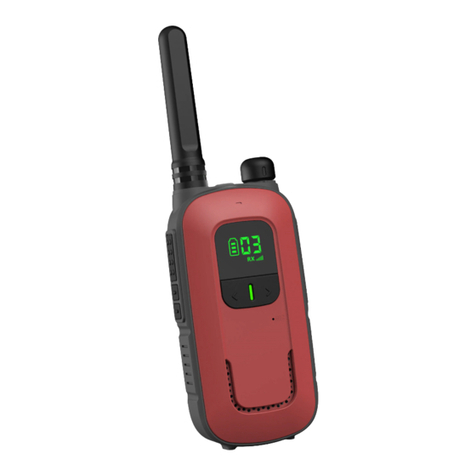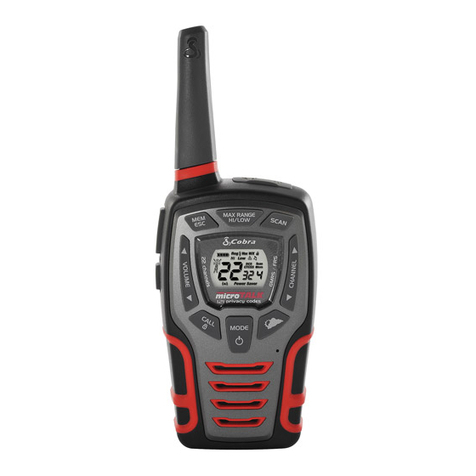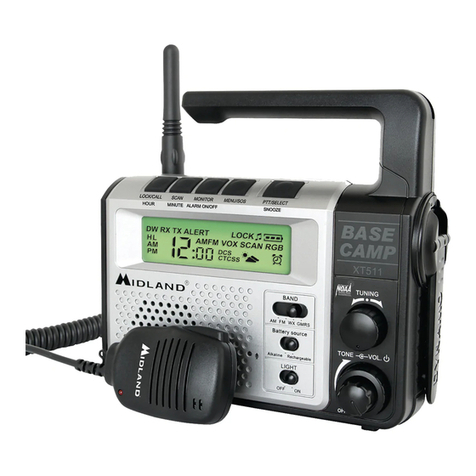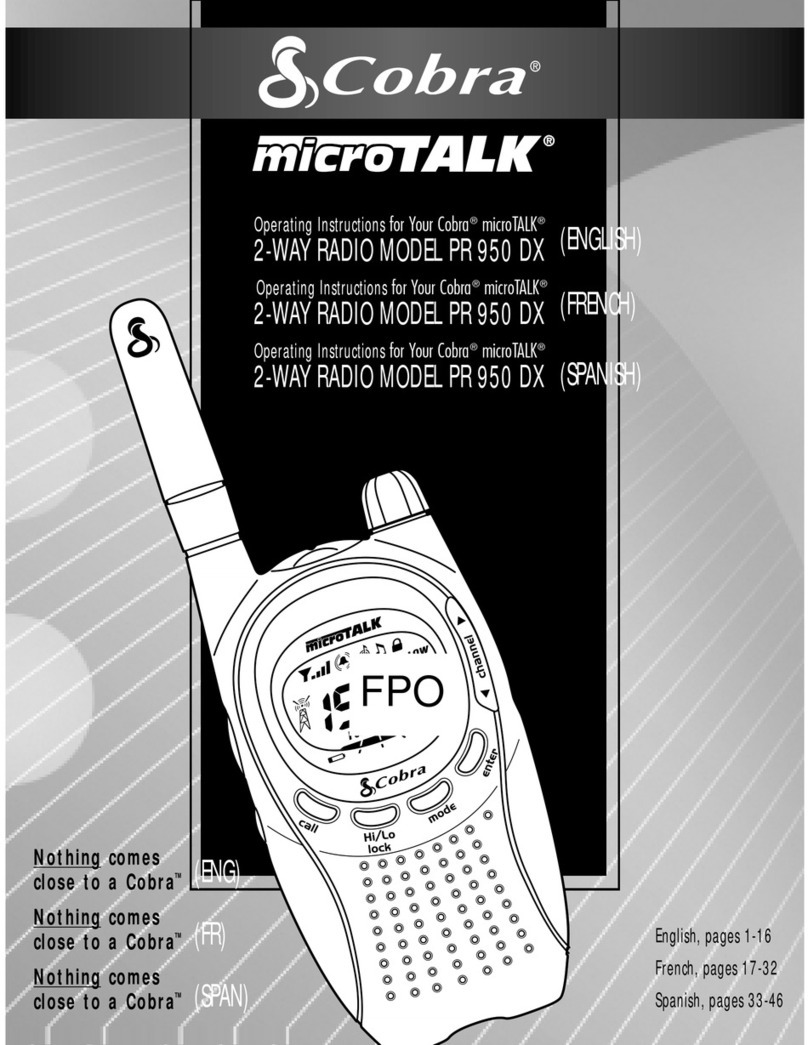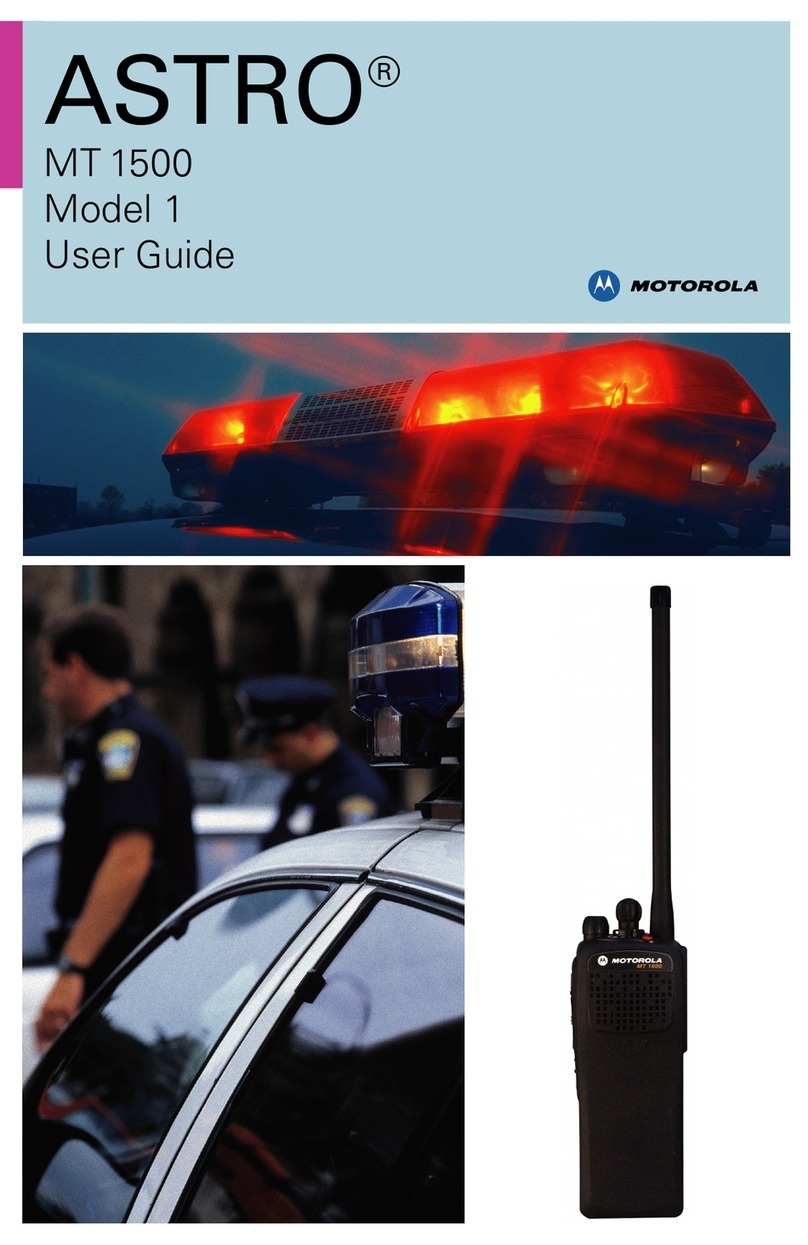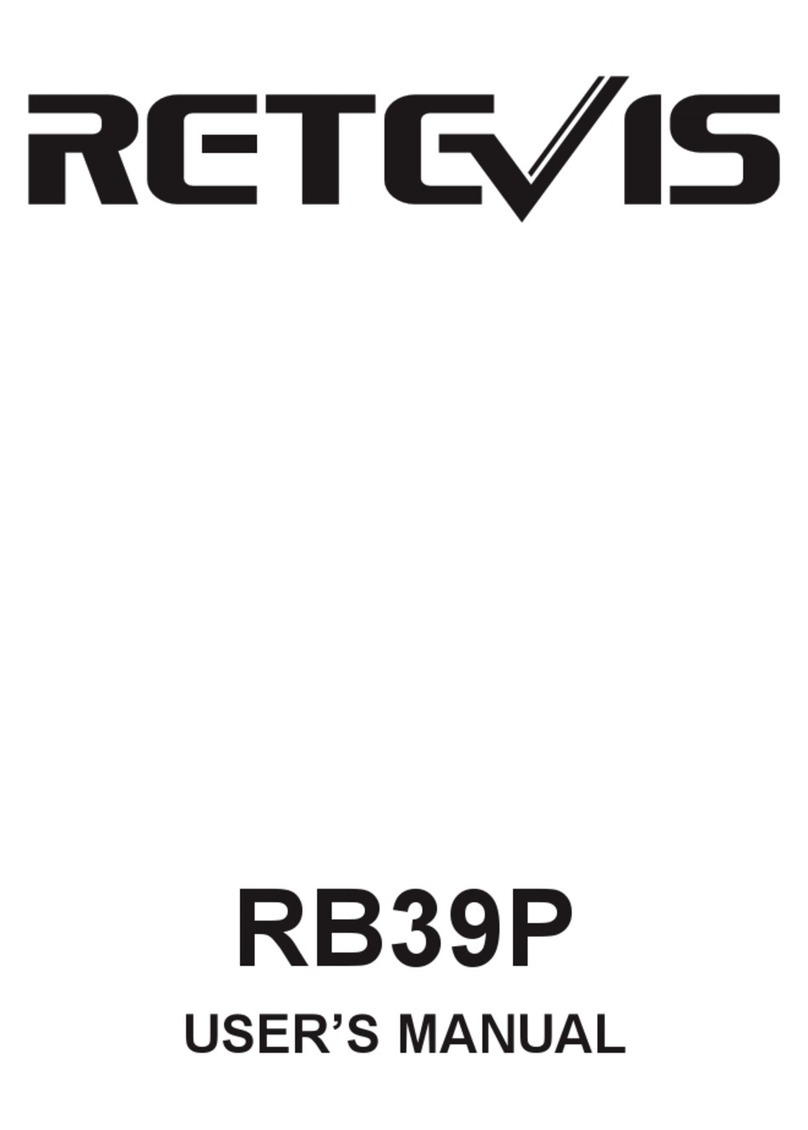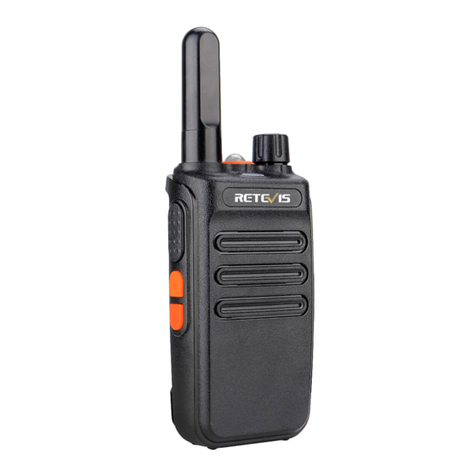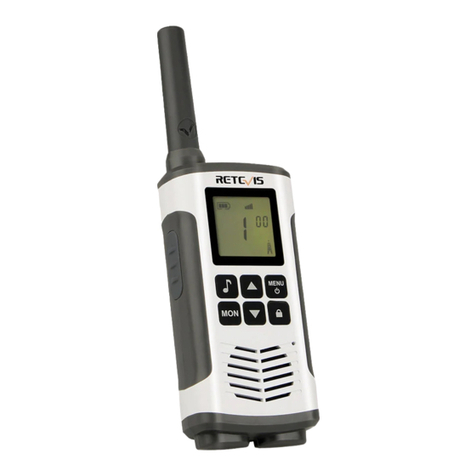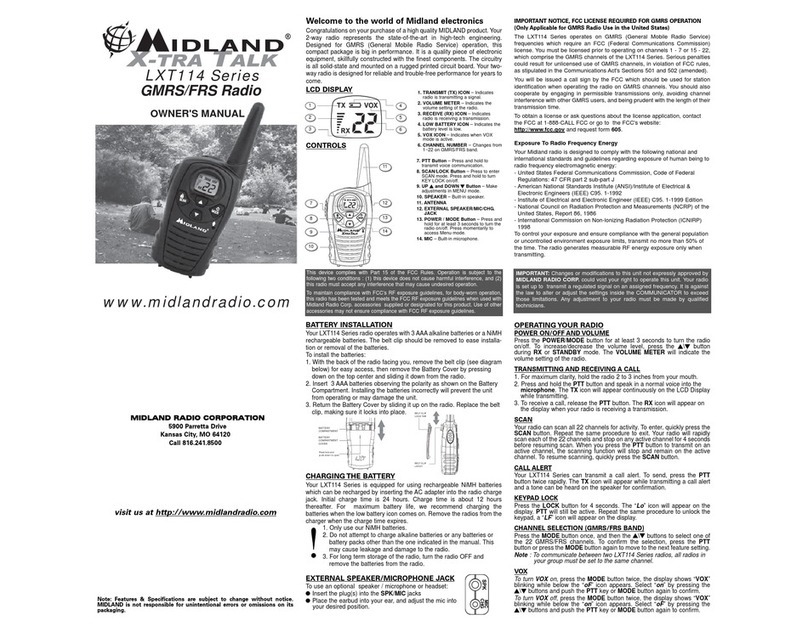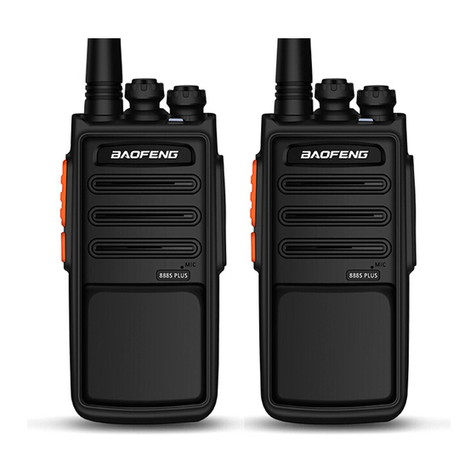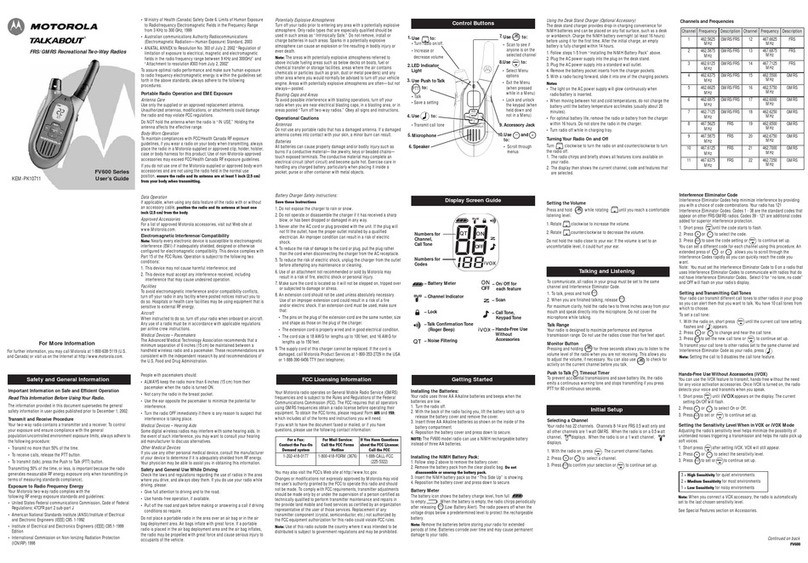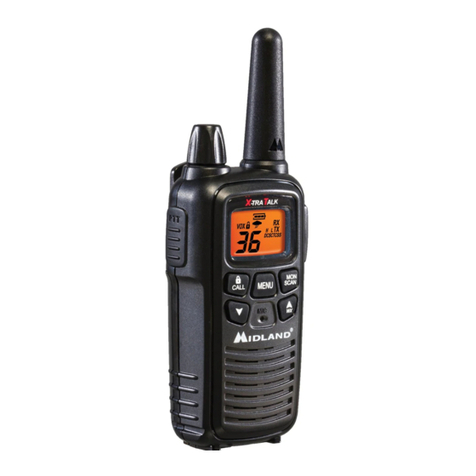SMP 908 User manual


INTRODUCTION
Thank you for purchasing Series Radio. The Series radios provide cost effective communications for businesses, they are the
perfect communications solution for all of todays fast-paced industries. Please read this guide carefully so you know how to properly
operate the radio before use.
Motorola Solutions (Shanghai) Co., Ltd.
6F, Building 11, No.1257, Mingyue Road
Pudong New District
Shanghai 201206, P.R.C.
+86 21 50800578
www.smp.com.cn
SMP, the stylized logo, and all other trademarks indicated as such herein are trademarks of Motorola Solutions (Shanghai) Co., Ltd.
All other product or service names are the property of their respective owners, © 2011 Motorola Solutions (Shanghai) Co., Ltd.

Safety and General Information
BEFORE USING THIS RADIO, READ THIS BOOKLET WHICH
CONTAINS IMPORTANT OPERATING INSTRUCTIONS
FOR SAFE USAGE AND RF ENERGY AWARENESS AND
CONTROL INFORMATION FOR COMPLIANCE WITH RF
ENERGY EXPOSURE LIMITS IN APPLICABLE NATIONAL
AND INTERNATIONAL STANDARDS.
Caution
The information provided in this document supersedes the general
safety information contained in user guides published before.
Compliance and Control Guidelines and Operating Instructions
for Mobile Two-Way Radios Installed in Vehicles
To control exposure to yourself and others and to ensure compliance
with the RF exposure limits, always adhere to the following procedures:
Guidelines
User awareness instructions should accompany device when
transferred to other users.
Do not use this device if the operational requirements described
herein are not met.
Instructions
Transmit no more than the rated duty factor of 50% of theTime.
To transmit (talk), push the Push-To-Talk (PTT) button or, for radios
equipped with VOX, speak into the microphone,The red LED will
illuminate when the radio is transmitting. To receive calls, release the
PTT button or, for radios equipped with VOX, stop talking. The red LED
will extinguish when the radio stops transmitting. Transmitting 50% of the
time, or less, is important because this radio generates measurable RF
energy exposure only when transmitting.
Transmit only when people outside the vehicle are at least the
Product Safety and RF Exposure for Mobile Two-Way Radios
Installed in Vehicles or as Fixed Site Control Stations
recommended minimum lateral distance away, as shown in Table
1, from the body of a vehicle with a properly installed antenna. This
separation distance will ensure that there is sufficient distance from
a properly installed (according to installation instructions) externally-
mounted antenna to satisfy the RF exposure requirements .
Table 1 below lists the recommended lateral distance for
people in an uncontrolled environment from the body of a
vehicle with an approved, properly installed transmitting
antenna (i.e., monopoles over a ground plane, or dipoles) at
several different ranges of rated radio power for mobile radios
installed in a vehicle.
NOTE
Mobile Radio Rated Power Minimum Lateral Distance from
Vehicle Body
Less than 7 watts 20 centimeters
7 to 15 watts 30 centimeters
16 to 39 watts 60 centimeters
40 to 110 watts 90 centimeters
When a mobile radio is used in conjunction with another co-located
transmitter such as a Vehicular Repeater, it is the vehicle operator's
responsibility to take appropriate steps to keep bystanders at the
required separation distance from the vehicle to ensure compliance with
the RF energy exposure limits for the general population.
If you are not sure of the rated power of your radio,contact
your SMP representative or dealer and supply the radio model
number found on the radio model label. If you cannot determine
the rated power out, then assure 90 centimeters separation
from the body of the vehicle.
NOTE
Table 1: Rated Power of Vehicle-Installed Mobile Two-Way Radio and
Recommended Minimum Lateral Distance from Vehicle Body.

Mobile Antenna Installation Guidelines
These mobile antenna installation guidelines are limited to metal body
motor vehicles or vehicles with appropriate ground planes.
Antennas should be installed in the center area of the roof or the trunk
lid taking into account the exposure conditions of backseat passengers
and according to the specic instructions and restrictions in the Radio
Installation Manual along with the requirements of the antenna supplier.
Trunk lid installations are limited to vehicles with clearly defined flat
trunk lids, and in some cases, to specic radio models and antennas.
Approved Accessories
Use only the SMP-approved, supplied accessory or a SMP-approved
replacement accessory. Unauthorized accessories, modifications, or
attachments could damage the radio and may result in non-compliance
with RF Safety Standards.
For a list of SMP-approved accessories, visit the following web site,
which lists approved accessories for your radio model: http://www.smp.
com.cn
Compliance and Control Guidelines and Operating
Instructions for Mobile Two-Way Radios Installed as Fixed
Site Control Stations
If mobile radio equipment is installed at a xed location and operated
as a control station or as a fixed unit, the antenna installation must
comply with the requirements in order to ensure optimal performance
and compliance with the RF energy exposure limits.
The antenna should be mounted outside the building on the roof or
a tower if at all possible.
As with all fixed site antenna installations, it is the responsibility
of the licensee to manage the site in accordance with applicable
regulatory requirements and may require additional compliance
actions such as site survey measurements, signage, and site
access restrictions in order to ensure that exposure limits are not
exceeded.
For additional installation information, see the guidelines for
minimum separation distances provided above in the Compliance
and Control Guidelines and Operating Instructions for Mobile Two-
Way Radios Installed in Vehicles.
Electromagnetic Interference/Compatibility
Nearly every electronic device is susceptible to electromagnetic
interference (EMI) if inadequately shielded, designed, or
otherwise configured for electromagnetic compatibility. It may
be necessary to conduct compatibility testing to determine if
any electronic equipment used in or around vehicles or near
xed site antenna is sensitive to external RF energy or if any
procedures need to be followed to eliminate or mitigate the
potential for interaction between the radio transmitter and the
equipment or device.
NOTE
Facilities
To avoid electromagnetic interference and/or compatibility conflicts,
turn off your radio in any facility where posted notices instruct you to do
so. Hospitals or health care facilities may be using equipment that is
sensitive to external RF energy.
Vehicles
To avoid possible interaction between the radio transmitter and any
vehicle electronic control modules, such as ABS, engine, or transmission
controls, the radio should be installed only by an experienced installer
and the following precautions should be used when installing the radio:
Refer to the manufacturer's instructions or other technical bulletins for
1.
recommendations on radio installation.
Before installing the radio, determine the location of the electronic
2.
control modules and their harnesses in the vehicle.
Route all radio wiring, including the antenna transmission line, as far
3.
away as possible from the electronic control units and associated
wiring.

Driver Safety
Check the laws and regulations on the use of radios in the area where
you drive. Always obey them.
When using your radio while driving, please:
Give full attention to driving and to the road.
Pull off the road and park before making or answering a call if
driving conditions so require.
Operational Warnings
For Vehicles With An Air Bag
Do not mount or place a mobile radio in the area over an air bag
or in the air bag deployment area. Air bags inate with great force.
If a radio is placed in the air bag deployment area and the air bag
inflates, the radio may be propelled with great force and cause
serious injury to occupants of the vehicle.
Potentially Explosive Atmospheres
Turn off your radio prior to entering any area with a potentially
explosive atmosphere. Sparks in a potentially explosive atmosphere
can cause an explosion or fire resulting in bodily injury or even
death.
The areas with potentially explosive atmospheres include fueling
areas such as below decks on boats, fuel or chemical transfer or
storage facilities, and areas where, the air contains chemicals or
particles such as grain, dust or metal powders. Areas with potentially
explosive atmospheres are often, but not always posted.
Blasting Caps and Blasting Areas
To avoid possible interference with blasting operations, turn off your
radio when you are near electrical blasting caps, in a blasting area,
or in areas posted: "Turn off two-way radio”. Obey all signs and
instructions.
For radios installed in vehicles fueled by liquefied petroleum gas,
refer to the local standard for storage, handling, and/or container
information.

CONTENTS
Features and Precautions....................................................1
Supplied Accessories/Optional Accessories.....................2
Supplied Accessories.......................................................................2
Optional Accessories .......................................................................2
Initial Installation ..................................................................3
Mobile Installation ............................................................................3
DC Power Cable Connection ...........................................................4
Power Supply Voltage Display ......................................................... 6
Antenna Connection ........................................................................6
Accessories Connections.................................................................7
Getting Acquainted ..............................................................8
Front panel.......................................................................................8
Rear panel .......................................................................................9
Display .............................................................................................9
Microphone ......................................................................................10
Working Mode(Amateur Transceiver or Professional
Transceiver)
........................................................................11
Basic Operations .................................................................12
Switching the Power On/Off ............................................................12
Adjusting the Volume ......................................................................12
Switch between VFO and Channel mode ....................................... 12
Adjusting Frequency/Channel Through Selector Knob....................12
Receiving .........................................................................................12
Transmitting .....................................................................................12
Transmitting Tone-Pulse ..................................................................13
Transmitting Optional Signaling ...................................................... 13
Channel Edit ....................................................................................13
Channel Delete ................................................................................13
Shortcut Operations.............................................................14
Squelch Off/Squelch Off Momentary................................................14
Squelch Level Setup ........................................................................14
Frequency/Channel Scan ................................................................14
Channel Scan ..................................................................................14
CTCSS/DCS Encode and Decode Setup ........................................14
CTCSS Scan....................................................................................15
DCS Scan ........................................................................................15
High/Mid/Low Power Switch ............................................................ 15
Compander (Decrease the background noise and enhance audio
clarity ..................................................................................................15
Offset Direction and Offset Frequency Setup .................................. 16
Keypad Lockout ...............................................................................16
Current Voltage Enquiry...................................................................16
Auto-Dialer Setup.............................................................................16
Transmitting Edited DTMF Tones in the Auto-dialer Memory........... 17
General Setting.....................................................................18
01 Frequency Channel Step Setup..................................................18
02 DTMF, DTMF ANI, 2Tone or 5Tone Signaling.............................18
03 Sending 2-Tone Call.................................................................... 19
04 Sending 5-Tone Call.................................................................... 19
05 Sending DTMF call .....................................................................19
06 Signaling Combination Setup......................................................19

CONTENTS
07 HIGH/MID/LOW Power Selection ...............................................20
08 Band-width Selection ..................................................................20
09 TX OFF Setup............................................................................. 21
10 Busy Channel Lockout ................................................................21
11 Editing Channel Name ................................................................21
12 Reverse TX/RX ...........................................................................21
13 Talk Around .................................................................................22
14 Voice Compander ......................................................................22
15 Scrambler Setup (Encryption).....................................................22
16 Radio's DTMF SELF ID ENQUIRY ............................................22
17 Radio's 5TONE SELF ID ENQUIRY ..........................................23
18 Voice Prompt...............................................................................23
19 TOT (Time-out timer)...................................................................23
20 APO (Auto power off) ..................................................................23
21 DTMF Transmitting Time............................................................. 24
22 Squelch Level Setup ...................................................................24
23 Scan Dwell Time Setup...............................................................24
24 LCD Backlight .............................................................................24
25 Pilot Frequency ........................................................................... 25
26 Display Mode Setup....................................................................25
27 PIN Setup ...................................................................................25
28 Address List ............................................................................... 26
29 Factory Default............................................................................26
Microphone Operation .........................................................27
Function Setup By Microphone Keypad...........................................27
Squelch Level ..................................................................................27
Optional Signaling ...........................................................................27
Scan Skip ........................................................................................28
Frequency/Channel Scan ............................................................... 28
Busy Channel Lockout .....................................................................28
Reverse TX/RX ................................................................................28
TOT (Time-out timer)........................................................................29
CTCSS/DCS Encode and Decode...................................................29
Talk Around .....................................................................................29
Beep Tone........................................................................................29
HIGH/MID/LOW Power Selection ....................................................29
LCD Backlight .................................................................................30
Cable Clone ..........................................................................31
Programming Software Installing and Starting (in windows
XP system) ............................................................................32
Maintenance..........................................................................33
Default Setting after Resetting(VHF) ...............................................33
Default Setting after Resetting(UHF) ...............................................33
Default Setting after Resetting(UHF) ...............................................33
Trouble Shooting.............................................................................. 33
Specications .......................................................................34
Appendix ...............................................................................35
50 groups CTCSS Tone Frequency(Hz) ..........................................35
1024 groups DCS Code...................................................................35

1
1Features and Precautions
Display on a large LCD with adjustable brightness, convenient for
usage in different environments.
There are Amateur operation mode and Professional operation
mode to preset.
200 programmable memorized channels, identied by editing name.
Programming different CTCSS, DCS, 2Tone, 5Tone in per channel,
rejecting extra calling from other radios.
Various scan functions including CTCSS/DCS Scan function.
Using
5Tone to send Message, Emergency alarm, Call all, ANI,
Remotely kill, Remotely Waken, etc.
Automatic
calling Identification function by DTMF--ANI or 5Tone--
ANI .
Optional scramble function to increase confidentiality (Customer
optional).
Compander function for decrease the background noise and
enhance audio clarity, it can set compander ON/OFF per channel.
Different band width per channel,
25K for wide band, 20K for
middle band ,or 12.5K for narrow band.
Customizable password on boot and programming to protect user
privacy and information safety.
Features
This transceiver is designed for a 13.8V DC power supply. Don't use
a 24V battery to power on the transceiver.
Do not place the transceiver in excessively dusty, humid or wet
areas, nor unstable surfaces.
Please keep it away from interferential devices (such as TV,
generator etc.)
Do not expose the transceiver to long
periods of direct sunlight nor place it
close to heating appliances.
If an abnormal odor or smoke is
detected coming from the transceiver,
turn OFF the power immediately.
Contact an Anytone service station or
your dealer.
Do not transmit with high output power
for extended periods; the transceiver
may overheat.
Please observe the following precautions to prevent fire, personal
injury, or transceiver damage:
Precautions
When programming the transceiver, please rstly read the factory initial
data, then change frequency,signalling and etc. Otherwise errors may
occur because of improper frequency band and etc.
Fitted software: SMP908

2
2
Supplied Accessories/Optional Accessories
Supplied Accessories
Optional Accessories
After carefully unpacking the transceiver, identify the items listed in the table below. We suggest you keep the box and packaging.
SMP908 Transceiver
Spare Fuses (one pair)
[92Q183201]
Cloning Cable
[30Q183601]
Desktop
Microphone
Car AntennaUSB Programming
Cable [30Q183301]
Cigar-Plug Connection
Line [30Q183401]
Regulated Power Supply
External Speaker
User Manual in Chinese/ English
Mobile Mounting
Bracket [10Q183001]
DC Cable & Fuse Socke
[25Q183101]
Hardware Kit for Bracket [01Q183501]
Black screws
4PCS(M4X8mm)
Tapping screws
4PCS(M5X8mm)S-Washer
Microphone DTMF with
keyboard[50Q182901]
Note:
All item number may change due to version upgrading.
The availability of the accesories may be different for specied sales territory.
For more information on new items, pls check the SMP website:
http://www.smp.com.cn

3
To install the transceiver, select a safe, convenient location inside your
vehicle that minimizes danger to your passengers and yourself while the
vehicle is in motion. Consider installing the unit at an appropriate position
so that knees or legs will not strike it during sudden braking of your
vehicle. Try to pick a well ventilated location that is shielded from direct
sunlight. Meanwhile, please keep the location away from an air bag and
its work area.
Install the mounting bracket in the vehicle using the supplied self-
1.
tapping screws (4pcs) and at washers (4pcs).
Position the transceiver, then insert and tighten the supplied
2.
hexagon SEMS screws.
Double check that all screws are tightened to prevent vehicle
vibration from loosening the bracket or transceiver.
3
Car body
Washer (M5)
Tapping screw
(M5x20mm)
Mounting bracket
Initial Installation
Mobile installation Determine the appropriate angle of the transceiver, using the 3 screw
hole positions on the side of the mounting bracket.

4
Connect the DC power cable to the transceiver's power supply
6.
connector.
Press
the connectors rmly together until the locking tab clicks.
3
Red
Black
Ext. Power jack
DC power cable
Initial Installation
DC Power Cable Connection
Mobile Operation
In many cars,the cigar-lighter plug is always powered. If this is the case, you
cannot use it for the ignition key on/off function.
The vehicle battery must have a nominal rating of 12V. Never
connect the transceiver to a 24V battery. Be sure to use a 12V
vehicle battery that has sufficient current capacity. If the current
to the transceiver is insufficient, the display may darken during
transmission, or transmitting output power may drop excessively.
When the ignition key is turned to ACC or ON(Start) position with
7.
the radio turned off, the power switch illuminates. The illumination
will be turned off when the ignition key is turned to the off position.
Route the DC power cable supplied with the transceiver directly
1.
to the vehicle's battery terminals using the shortest path from the
transceiver.
Please
do not use the cigarette lighter socket as some cigarette
lighter sockets introduce an unacceptable voltage drop or low current
supply.
The entire length of the cable must be dressed so it is isolated from
heat, moisture, and the engine secondary (high voltage) ignition
system/ cables.
After installing cable, in order to avoid the risk of damp, please
2.
use heat-resistant tap to tie together with fuse box. Don't forget to
reinforce whole cable.
In order to avoid the risk of short circuit, please cut down
3.
connection with negative (-) of battery, then connect with radio.
Confirm the correct polarity of the connections, then attach the
4.
power cable to the battery terminals; red connects to the positive (+)
terminal and black connects to the negative (-) terminal.
Use the full length of the cable without cutting off excess even if
the
cable is longer than required. In particular, never remove the fuse
holders from the cable.
Reconnect any wiring removed from the negative terminal.
5.
If the ignition-key on/off feature is desired(optional feature),use the
optional QCC-01(For Cigar-Plug connection) cable. Connect one of
the cables between the ACC terminal or a Cigar-Plug that operates
with the vehicle ignition or ACC switch on the vehicle and EXT
POWER jack on the rear side of the unit.
Locate the power input connector as close to the transceiver as possible.

5
3
Red
Black
DC power supply
DC power cable with fuse holder [25Q183101]
DC power
supply
Ext. Power jack
ACC terminal
Cigar-Plug connection
Initial Installation
Before connecting the DC power to the transceiver, be sure to switch
the transceiver and the DC power supply OFF.
Do not plug the DC power supply into an AC outlet until you make all
connections.
In order to use this transceiver for xed station operation, you will
need a separate 13.8V DC power supply (Users purchase).Please
contact local dealer to require.
The recommended current capacity of your power supply is 12A.
Connect the DC power cable to the regulated DC power supply
1.
and ensure that the polarities are correct. (Red: positive, Black:
negative).
Do not directly connect the transceiver to an AC outlet.
Use the supplied DC power cable to connect the transceiver to a
regulated power supply.
Do not substitute a cable with smaller gauge wires.
To turn on the unit, press the power switch manually while it is
illuminated. (While ignition key is at ACC or ON position)
When the ignition key is turned to ACC or ON position with the
8.
radio's power switch on, the unit turns on automatically and the
power switch will be lit. Turn the ignition key to OFF position or
manually turn the power switch off to shut down the radio.
Using extra cable,power consumption:
9. 3-5MAH.
Without this function,user can turn on/off radio by Power knob.
10.
Connect the transceiver's DC power connector to the connector
2. on
the DC power cable.
Press the connectors rmly together until the locking tab clicks
.
Fixed Station Operation

6
3
Initial Installation
REPLACING FUSES
If the fuse blows, determine the cause, then correct the problem.
After the problem is resolved, replace the fuse. If newly installed
fuses continue to blow, disconnect the power cable and contact your
autho-rized dealer or an authorized servi-cecenter for
assistance.
Only use fuses of the specified type and rating, otherwise the
transceiver could be damaged.
After connecting the transceiver to the power supply, the supply voltage
can be displayed on LCD by pressing the key together with the
key.
The display immediately changes as the voltage supply changes, It
also displays voltage during transmission.
The transceiver will return to its normal operation when the power is
switched ON or repeat above operation.
Before operating, install an efcient, well-tuned antenna. The success
of your installation will depend largely on the type of antenna and its
correct installation. The transceiver can give excellent results if the
antenna system and its installation are given careful attention.
Use a 50Ω impedance antenna and low-loss coaxial feed-line that
has a characteristic impedance of 50 Ω, to match the transceiver input
impedance. Coupling the antenna to the transceiver via feed-lines having
an impedance other than 50Ω reduces the efficiency of the antenna
system and can cause interference to nearby broadcast television
receivers, radio receivers, and other electronic equipment.
Fuse Location Fuse Current Rating
Transceiver 15A
Supplied Accessory DC
power cable 15A
If you use the transceiver for a long period when the vehicle battery is
not fully charged, or when the engine is OFF, the battery may become
discharged, and will not have sufcient reserves to start the vehicle. Avoid
using the transceiver in these conditions.
The range of displayed voltage is only from 7V to16V DC, because the
displayed value is estimated, please use a voltmeter when a more precise
reading is desired.
Power supply voltage Display
Antenna Connection
Important
Transmitting without first connecting an antenna or other matched
load may damage the transceiver. Always connect the antenna to the
transceiver before transmitting.
All xed stations should be equipped with a lightning arrester to reduce
the risk of re, electric shock, and transceiver damage.
The possible locations of antenna on a car are shown as following:

7
3
Ground
Error
Initial Installation
External Speaker
Microphone
PC Connecting
If you plan to use an external speaker, choose a speaker with an
impedance of 8 Ω. The external speaker jack accepts a 3.5 mm (1/8")
mono (2-conductor) plug.
For voice communications, connect a microphone equipped with
an 8-pin modular plug into the modular socket on the front of the
main unit. Press rmly on the plug until the locking tab clicks. Attach
the supplied microphone hanger in an appropriate location using the
screws included in the screw set.
To use the SMP908 software, please rstly connect the radio with
PC by using the optional programming cable 30Q183301 (via multi-
functional microphone jack). Please contact dealer to purchase
programming cable and get free programming software.
External speaker adopt double port BTL, please care about the connecting
way. The speaker can not connect with the ground, otherwise the speaker
will be fault. The wrong connecting way as the following picture.
Accessories Connections
Microphone
connector
Microphone [50Q182901] Antenna
External speaker

8
4
NO. KEY FUNCTION
1Pow(Power) Power on/Off
2VOL Adjust Volume Key
3Main Dial Change frequency, memory channel and scan
direction etc.
4FUNC/SET Function Key
5V/M/MW Switches between VFO mode and Channel
mode
6MHz/SHIFT Step Size Key ( step:1MHz)
7TS/DCS/LOCK Sets CTCSS and DCS value
8CALL/H/L Call key
9SQL/D Squelch off
10 Data Terminal/
Mic.connector
Data reading/writing, cloning and Microphone
connection port
11 TX lights during Transmitting
NO. KEY FUNCTION
4FUNC/SET Conrms the selective functions and exit
5V/M/MW Stores data into channels
6MHz/SHIFT Sets offset direction and offset frequency
7TS/DCS/LOCK Sets Keypad lock function
8CALL/ H/L
Switches between HI, MID and LOW power
transmission
9SQL/D Compander mode on/off
NO. KEY FUNCTION
5V/M/MW Erase the memory
6MHz/SHIFT Switches between Wide/ Narrow band
7TS/DCS/LOCK Auto dialer
8CALL/H/L
Enters clone data function mode
9SQL/D Enters power supply voltage indication mode
NO. KEY FUNCTION
4FUNC/SET Press and hold for 2s to enter the Setting
mode
9SQL/D Monitor mode
Getting Acquainted
Front panel Press key until icon appears then press the following
key.
Press key and following key together to activate
following function:
Functions that require continuous pressing following key
to be activated
Basic Functions

9
4
21
NO. CONNECTOR FUNCTION
1E x t . P o w e r
Jack
Terminal for connecting optional cable QCC01
for use with ignition key On/Off function.
The radio will auto power on when car is driving.
The radio will auto power off when car stops.
2Ext.Speaker
Terminal Terminal for optional external speaker SP01
3Antenna
Connector Connection for 50Ω coaxial cable and antenna.
NO. KEY
Å
FUNCTION
1 SQL Squelch level.
2 MIn channel mode.
3 Indicates the channel number in channel mode.
4Decimal point
Channel skip.
5Decimal point Indicates the decimal point of frequency and the
scanning function.
6 Indicates the frequency or memory name.
7Signal is being received or monitor.
8Signal strength of receiving and transmitting.
9Compander.
10 Keypad lock .
11 DCS Set DCS function.
12 Set CTCSS function.
13 + _Offset frequency direction.
14 Scramble (requires optional components).
15 A Auto power off.
16 Nar Narrow band.
17 LO Low power.
18 Mi Middle Power.
19 Pressing key.
3
Getting Acquainted
DISPLAY
Rear panel
3
1
2
13 10
11
12
14
4567
8
9
15
16
17
18
19 13

10
4
NO. KEY FUNCTION
1UP Increase frequency ,channel number or setting value.
2DOWN Decrease frequency, channel number or setting value.
3PTT Press the PTT (Push-TO-Talk) key to transmit.
4Number Key Input VFO frequency or DTMF dial out etc..
5DTMF ON/
OFF Switches between DTMF dialing or function operating.
6LOCK Switch Locks out the UP 、Down、Numerical keys and Function
keys.
7MIC Speak here during transmission.
Key Pad Serial Data
+5V
DOWN
UP
MIC GND
MIC
PTT
GND
microphone MIC Connector Diagram(in the front view of connector)
Getting Acquainted

11
5
According to practical application,you can set the radio works as
Amateur Transceiver mode or Professional Transceiver mode . There
are also 2 levels operation menu to set functions as you need. It is easy
and convenient (From No.1 to No. 15 are channel function setup,From
No.15 to No.29 are general setting setup).
1.
In PC software's "General
Setting"menu ,choose "Display Mode" to select Amateur
Transceiver mode or Professional Transceiver mode.
:Please refer to "Display Mode" in Page 25.
2. Except setting as "CH" mode, others
considered as Amateur transceiver mode. Under this mode,press
key to switch between Channel mode and VFO mode .
Professional Transceiver Mode
3. When
set display mode as "CH",it enters
into Professional Transceiver mode.At
this mode,except scan,other shortcut
operation can't operate.And from No.1-
17 menu in function setting will be
auto-hidden,They should be set by
PC software.If there is corresponding
name for current channel,the LCD
will display current channel name
Otherwise,it shows current channel number. (As pic 4) (As pic 5)
Under every mode, from No. 18-29 menu in
4. general setting can be
changed and saved.
VFO Mode(Frequency mode)C. :
This mode shows only frequency
on the display. Shortcut operation
and Channel setting will be
changed & stored as the latest
value permanently.Once the radio is
turned off or changed to new VFO frequency, the latest setting is
remained until next change.(As pic 3)
If transceiver programmed as professional transceiver mode and
locked,you can't return to amateur transceiver mode by manual
operation from general setting.
(Pic 1)
(Pic 2)
(Pic 4)
(Pic 5)
Frequency + Channel modeA. : When set display as"FR",it enters
into Frequency+Channel mode, new
setting of channel operation and
shortcut operation can be temporarily
used by user. Once the radio is
turned off or switched to another
channel, the temporary setting will be
erased and back to initial settings.(As pic 1)
Channel+Name Tag ModeB. : When set display as "NM",it enters
into Channel +Name Tag mode. At this mode, it will display
corresponding channel name when
the current channel is edited with
name. Otherwise, it will display
frequency + channel. Its operations
are the same as frequency + channel
mode.(As pic 2)
(Pic 3)
WORKING MODE (AMATEUR TRANSCEIVER OR PROFESSIONAL TRANSCEIVER)

12
In standby, press key or Microphone's
key until appear , this indicates current
channel in channel mode. Repeat above
6
Basic Operations
Switching The Power On/Off
Adjusting The Volume
Switch between VFO and Channel mode
Adjusting Frequency/Channel THROUGH SELECTOR KNOB
Receiving
according to the option selected during installation Press the switch
or turn the ignition key to ACC (speed up) or ON (startup) position to
power on radio . Press the key for 1s or turn the ignition key to OFF
position to turn off.
When the channel you are operating is
called, the screen shows and field
intensity, in this way, you can hear the calling
from transmitting party.
Under frequency (VFO) mode, you can change the current
1.
frequency to the desired one through selector knob; Turn clockwise
to increase frequency; turn counterclockwise to decrease. Every
gear will increase or decrease one step. Press key, the
decimal point of frequency in screen will be auto-hidden. In this
status, turn selector knob or Microphone [ / ] key will
increase or decrease frequency quickly by 1MHz step .
Under channel mode, you can change the current channel to the
2.
Turn the VOL knob clockwise to increase the audio level,
counterclockwise to decrease.
During communication, volume can be adjusted more accurate.
5k, 6.25k, 8.33K,10k, 12.5k, 20k, 25k, 30k and 50k total nine step size
available for this radio.
If the transceiver has set at higher squelch level, it may fail to hear the calling.
operation to switch between Frequency mode
(VFO) and Channel mode.
desired one through selector knob, clockwise turn to the forward
channel, anticlockwise turn to the backward channel. In relative
working mode, Microphone's [ / ] key has same
function for adjusting frequency and channel.
Transmitting
Press and hold key or press MIC's key to monitor for a while
to conrm the channel desired is not busy. Release or press Mic's
key to return standby status,Then press and hold [PTT] key to speak
into microphone.
Please hold the microphone approximately 2.5-5.0cm from your lips
,
and then speak into the microphone in your normal speaking voice to
get best timbre.
When the channel you are operating is called,the screen shows BUSY
and field intensity,you can't hear the calling from transmitting party,it
means current channel receives a matching carrier but unmatching
signaling(Refer to CTCSS/DCS encode and decode or Optional Signaling
setup).

13
Basic Operations
Transmitting Tone-Pulse
Transmitting OPTIONAL SIGNALING
Press and hold [PTT] key, then press Microphone [ ] key to
transmit current selected tone-pulse signal.
Press and hold [PTT] key, then press Microphone key or press
key in front panel or press Mic's key to transmit pre-stored and
selected DTMF/2Tone/5Tone optional signaling.
Channel Edit
Channel Delete
Under frequency mode (VFO), turn
1.
selector knob to select the desired
frequency or input frequency by MIC's
numeric keys.
Press
2. key to enter CTCSS/DCS
signaling setup, turn selector knob to
select the desired signaling.
Press
3. key, LCD appears ,
icon and current channel number,
icon ashing means current channel is
Under channel mode, turn selector knob to select channel which
1.
you want to delete.
Press
2. key and key together, current channel will be
deleted and emitted a prompt voice. icon ashing means current
channel is deleted.
empty.
Turn selector knob to select the desired channel number to store.
4.
Press
5. key, , icon and channel number disappears and
emit a prompt voice, thus the channel storage succeed.
6
Press and hold [PTT] key, LED lights RED and power intensity showed in
screen indicates it is transmitting, release to receive.
Table of contents
Popular Two-way Radio manuals by other brands

Motorola
Motorola TALKABOUT EM1000 series user guide
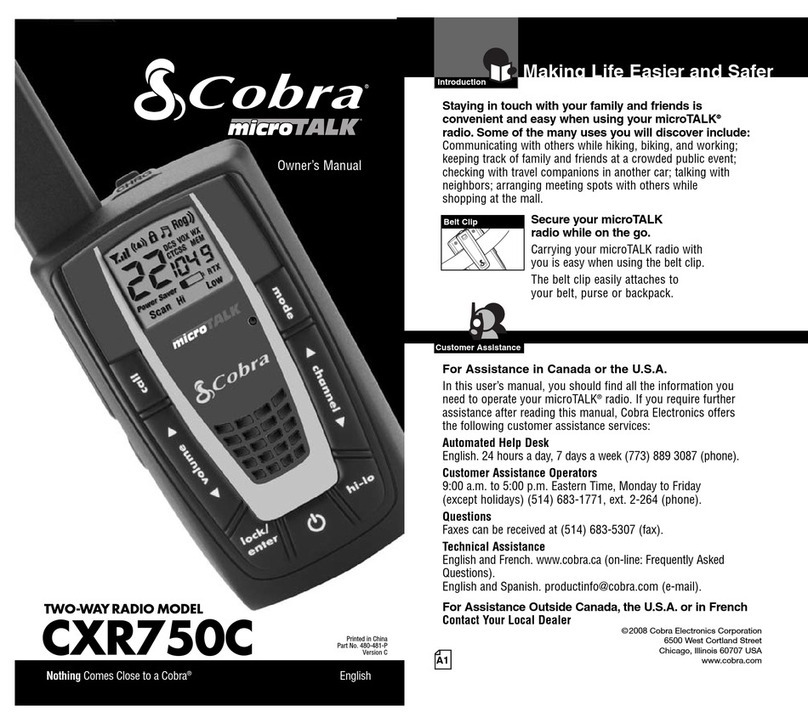
Cobra
Cobra MICROTALK CXR750C owner's manual

Motorola solutions
Motorola solutions XE Carry Case quick start guide
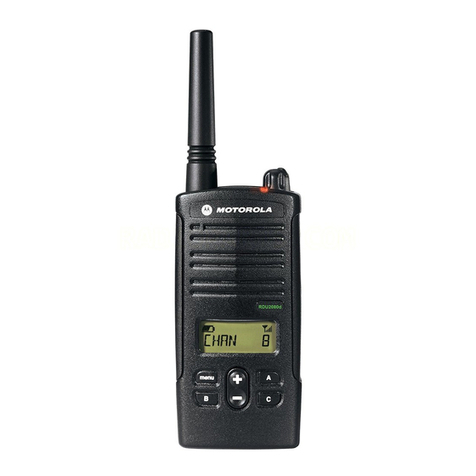
Motorola
Motorola RDU2080d - RDX Series On-Site UHF 2 Watt 8 Channel Two Way Business... user guide

Tesunho
Tesunho TH-518U user manual
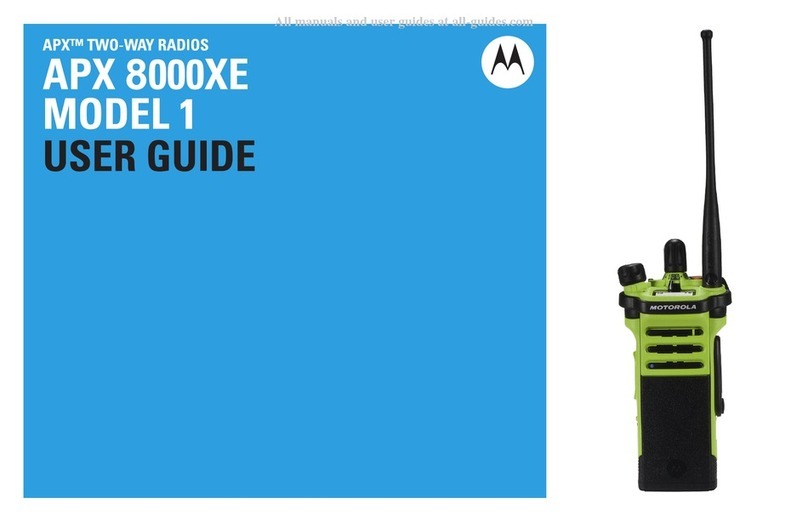
Motorola
Motorola APX 8000XE 1 user guide
